Table of Contents
The nature of slimes handled in the treatment of gold- and silver-ores has been discussed in technical literature to a considerable extent. The subject of slime-filtration from the practical worker’s standpoint has also received much comment, and scattered through the literature of the subject are descriptions of many slime-filtration installations. Articles of this nature serve a valuable purpose and assist materially in the design of new and the improvement of old plants. The subject of the physics of slime-filtration has been touched upon to only a slight extent. The underlying principles are worthy of more intensive study and experimentation than they have received, and the main purpose of this paper is to present the results of such study and experimental work as will serve to make clear in part at least many of the principles which control the filtration of slime.
Nature of Slime
Much has been written concerning an accurate definition of the term “ slime,” but no comprehensive definition seems to be generally accepted. The reason for this is clear. A slime consists of at least three different substances, each, when separated, possessing distinctly different physical and to a certain extent chemical properties. These substances are extremely fine sand, a colloidal material which may be and generally is in a coagulated condition, and a colloidal material which is in a non-coagulated condition. Suspending a slime in a relatively large volume of water by shaking and allowing sedimentation to take place, results in the fine sand settling out with comparative rapidity, followed by the coagulated material, which settles much more slowly and finally a certain portion remains indefinitely suspended. To the settled, coagulated portion some writers have given the term gel, and to the suspended portion the term sol. The physical properties which distinguish the fine sands are, the angular character of the grains and the comparatively rapid settling in water. With most quartzose ores the sand grains are composed of silica, although constituents of the ore, such as silicates or oxides, also characterize the sand portion of the slime. The coagulated colloid consists of aggregates of rounded grains together with individual grains, settles much less rapidly, possesses the property of flocculation and deflocculation, has the property of absorbing certain dyes, and a distinctive chemical composition. Clays and hydrated silica are the two colloids most likely to occur in quartzose ore. The former is a common constituent of many ores, the latter is perhaps seldom present. For practical purposes clay, or hydrated aluminum silicate, may be considered to be the chief colloidal constituent, and, mixed with fine sand, to constitute the coagulated portion of a slime. Inasmuch as the ordinary mill-slime is quite well coagulated by the liberal use of lime, the metallurgist has to deal only with mixtures of fine sands and coagulated colloid.
The distinctive properties of a slime depend upon the relative proportions of fine sand and colloid. Assuming all colloid and no fine sand, we would have a material which could not be leached, and which would filter very slowly and under certain conditions not at all; assuming all fine sand and no colloid, we would have a leachable material. In a moist condition a slime may be likened to a clay; with a large proportion of sand a “ short clay ” or a clay of moderate plasticity would be the result; with a small proportion of sand a “fat” clay or a clay with a high degree of plasticity would result. With sufficient moisture a slime partakes of the character of a viscous-fluid, and in this very fine sand will be almost indefinitely suspended, and little or no separation of fine sand from colloid will result. This latter statement is true of sand finer than a 150-mesh screen. With coarser sand, the coarse sand particles tend to settle out quite rapidly. By increasing the proportion of water successive crops of finer and finer sands can be settled out until a point is reached where the particles of coagulated colloid and the finest sands settle at the same rate. Beyond this point no further separation of sand from colloid is possible. No sharp line in the mechanical separation of sand from colloidal material being possible, it is necessary to use a definition which will embody some limitation as to the size of the maximum sand grain. Successive screen-sizes have been used; first a 100-mesh screen, then a 150-mesh screen, and, finally, a 200-mesh screen; and this is the accepted present practice in milling-work. All material in a pulp finer than a 200-mesh screen is considered as slime. The definition, that a slime is the unleachable portion of a mill-pulp, is still in use.
A more comprehensive definition than the foregoing is: a slime consists of a mixture of sands finer than 150- or 200- mesh screen with an amorphous clay-like material, consisting principally of hydrated aluminum silicate.
The general method of slime-treatment is to agitate the slime with a cyanide solution for a sufficient time to dissolve the gold, and then, either to filter off the surplus solution and displace the remainder with water, or to thicken the slime by settlement and decantation, and then to filter and displace the remaining solution by water.
The mechanical appliances in use for filtration are grouped as follows:
Suction-filters, or filters in which a vacuum is used to accelerate filtration.
A. Appliances using a thin slime-cake and practically continuous in their action.
(Oliver and Ridgway filters.)
B. Appliances using a thick slime-cake and intermittent in their action. (Moore
and Butters filters.)
Pressure-filters, or filters in which hydrostatic head, compressed air or pumps are used in order to secure greater pressures than are possible with a vacuum-pump.
These filters are intermittent in their action.
C. Ordinary filter-presses.
D. Sluicing filter-presses (Merrill filter-press).
E. Filtering-chambers or cylinders; filters in which the filtering-basket is inclosed in a cylinder. (Burt, Kelley, and Sweetland filter-presses.)
Centrifugal filters, or filters in which centrifugal force is used to separate solution from slime.
These filters are continuous in action.
The filters in Sections I. and II., with the exception of the Ridgway, employ vertical filtering-surfaces. The Oliver makes use of a revolving cylindrical surface as a filtering-surface. Centrifugal filters are in process of development, and have not as yet secured any foothold in gold-and silver-metallurgy. It is not improbable, however, that some comparatively simple filter based on the use of centrifugal force will be perfected, and will successfully compete with the other forms. At present the suction-filters are in greatest use. Of the pressure-filters, the ordinary filter-presses have gone out of use, except as clarifying-presses, and filters of groups D and E only are in use.
The development of slime-filtration is of interest. Filter presses and filtering-beds in vats were first used. The filtering-beds were soon discarded and the filter-press systematically developed. The size of the press was increased, mechanical devices to facilitate discharge and decrease the proportion of labor required were invented and introduced; but in spite of all this the cost of treatment in filter-presses remained high. In western America the filter-press never received much recognition, but in Australia filter-pressing was extensively introduced, and slime was successfully handled by this method. It remained for an American, Charles A. Merrill, to complete the last improvement in the filter-press. By the introduction of the sluicing-system the slime-cakes could be washed out of the filter-cells and the press operated without opening or separating the filter-plates for each charge. This improvement reduced the labor and cost and increased the effectiveness of the filter-press. The Merrill press represents the culminating point in the filter-press line of development in slime-filtration.
The Moore filter was the first suction-filter in the field, and, while it did not score any very decided success in the first installations, it did attract the attention of metallurgists to the idea involved. While the Moore Filter Co. was perfecting the mechanical features of its filter, the Butters filter was introduced, and so many of the difficulties of the Moore filter were overcome in the Butters, that this latter filter received wide-spread recognition and was introduced into many milling-plants. The Moore filter introduced the idea of the canvas-covered filtering-cell immersed in the slime-pulp and utilizing suction to draw the solution through the walls of the cell and to build up a cake. The necessary transfers are made by lifting the filtering-basket out of the pulp. The Butters filter introduced the idea of a stationary filtering-cell, and effected the transfers by pumping the slime-pulp and wash-water from the vat in which the filtering-cells were immersed. The relative merits of the two systems have been sufficiently discussed in the technical literature. Both the Moore and the Butters filter have reached a point where little or no further improvement seems possible. Like the Merrill, either one of these systems will satisfactorily meet the requirements of slime-filtration.
The combination of the ideas involved in the filter-press and the suction-filter is seen in group E, or the filtering-chambers. The Kelley, the Burt, and the Sweetland may be compared to a Butters filter installed in a pressure-tank.
The effort to secure a continuously-acting filter has resulted in two important types being developed, of which the Ridgway and the Oliver are the best known. Both of these filters utilize a comparatively thin slime-cake. Both operate very successfully, and compared with the thick-cake machines have decided advantages, briefly stated as : simplicity of design; probably lower capitalization-charges for equal capacities; lower operating-costs; and less attention required in the operation.
With the exception of the Oliver filter, the general method of operation of both suction- and pressure-filters is the same. The slime-pulp is delivered to the filter in the proportion of one of dry slime to from three to one of solution. The pulp is forced into the cells of the pressure-filters and a cake formed against the canvas walls of the cells, the surplus pulp, if any, is withdrawn, and wash-water forced in until the contained solutions are displaced. The cake is then forced off from the canvas surface, either by water or air or a combination of both, and sluiced out. In the vacuum-filter the filtering-cells are immersed in the pulp, a vacuum is formed, and a cake built up; the surplus pulp is then withdrawn either by lifting the filtering-cells out or by withdrawing the pulp by pumps, and the cakes are immersed in water for washing. In the Moore filter the cakes are discharged by forcing them off from the cell by water or air and dropping into a hopper for sluicing away; in the Butters the cake is forced off in the same way, but while still immersed in the wash-solution. The wash-solution is then withdrawn, either by decanting or pumping, and the slime-cake and surplus wash sluiced out. The Oliver filter performs the operations of cake-formation, washing, and discharge in continuous sequence. Three steps may be designated as common to all these filters: cake-formation, washing, and discharge. The cycle of operations of the more common forms of filters is shown in Fig. 1. Typical examples have been taken in each case.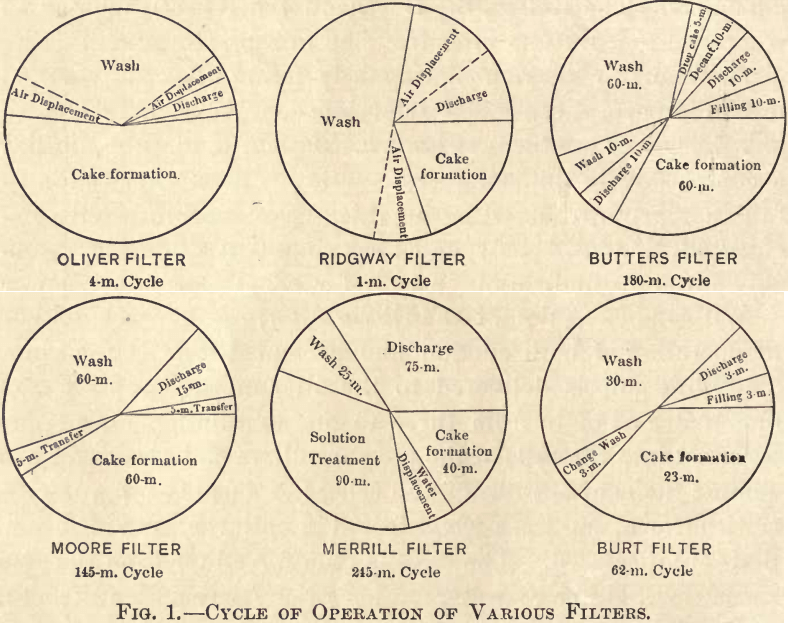
The conditions under which slime-cakes are formed and washed are the critical points to be considered; the discharge and sluicing away of the cake is a comparatively simple matter and requires no special comment. My experimental work was largely confined to suction-filtration, and pressure-filtration was only briefly studied. The method of carrying out the experiments may be summarized as follows: After trying out several different sizes and types of filter-cells a test-filter of 0.5 sq. ft. filtering-surface was decided upon, shown in Fig. 2. A ribbed wooden support with 1/8-in. grooves and 1/8-in. ribs was used to support the canvas surface. Brass side-strips and a slotted brass bottom-strip were used to protect the cake and to assist in measuring. A type slime was obtained by classifying a pulp from a Tonopah quartzose ore which had been crushed in a stamp-battery. The slime was settled by the use of lime, and then by repeated settlement all the coarse and as much of the fine sand as possible were settled out and removed.

The slime-pulp remaining was settled to a thickness giving a density of 1.3. The screen-analysis of this slime approximated:

Of this slime-pulp, 97.4 per cent, passed a 200-mesh screen. Fine sand passing a 100-mesh screen was used in securing the necessary mixtures. The filtrate was measured in a Woulff bottle, to which was attached a vacuum-gauge. The vacuum was obtained by a small single-acting pump exhausting from a 10-gal. vacuum-tank. A short length of hose connected the Woulff bottle with the tank. The shine-mixtures were made up in buckets and heated to the temperatures as required. Variations in pressure, temperature, and slime were the main points studied.
Filtering Rate
The rapidity with which a cake may be formed depends upon the filtering-rate of the slime, the thickness of the cake, the temperature and density of the pulp, and the intensity of the vacuum. The filtering-rate of a slime, which is numerically defined in this paper as the number of pounds of water drawn through 100 sq. ft. of filtering-surface per minute, depends, for a cake of given thickness, upon the character of the slime, the density of the slime-cake, the suction-pressure, the temperature, and, to a moderate extent, upon the character of the filtering- surface and its support. These factors are so interrelated that it is impossible to conduct any series of experiments which would exactly show the effect of varying them. At best the results are approximations.
Fig. 3 shows the variation of the filtering-rate with variable thickness of slime-cake both while building up and in clear water. The curves represent the averages of a number of tests in which temperature and pressure were practically the same for all. A No. 10 canvas was used. In carrying out the experiment the filter was immersed in the pulp for 5 or 10 min. and a cake built up. This cake was then quickly removed, its thickness measured, and the filter immersed in clear water. After determining the filtering-rate, the filter was replaced in the pulp and an additional thickness built up. The filtering-rate during building up was determined by calculation from the amount of water passing while building to a given thickness. The difference between the two curves is comparatively slight and indicates that the filtering-rate during building up a cake is greater in the pulp than in clear water for thin cakes, while for the thicker cakes the reverse is true.
Fig. 4 shows the effect of variation of pressure upon the filtering-rates of cakes of varying thickness. Three pressures were used—11.35, 17, and 21.5 in. of mercury. The last pressure is about the maximum obtainable in Nevada practice. The general effect of increase of pressure is to increase the filtering-rate. This is more marked with the thin cakes, while with the thick cakes all three curves tend to run together. With thick cakes the effect of an increase of pressure is to increase the density of the cake and thus reduce its permeability. With higher pressures this effect is more marked, and indi-
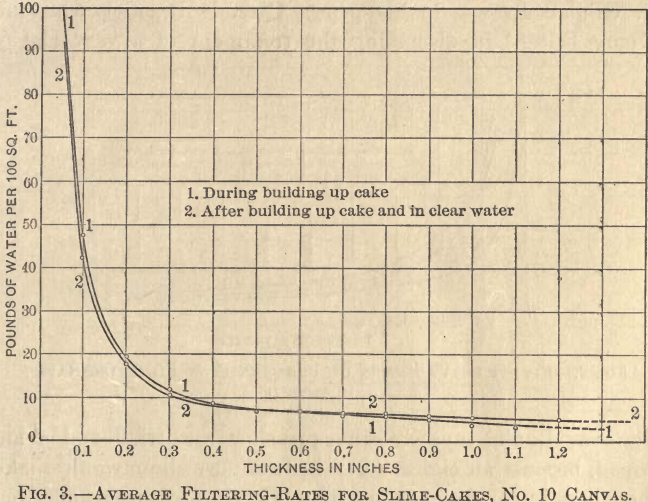
cates that a point would soon be reached where the increased pressure would result in decreased filtering-rate. This is particularly true of slime containing a small proportion of sand, and much less so with slimes containing a large proportion of sand. Sweetland, in his paper, Pressure Filtration, shows for pressures up to 65 lb. per sq. in. a progressive increase in the filtering-rate for slime-cakes varying from 0.5 to 1.75 in. The slime used in the Sweetland experiments was obtained from the Goldfield Consolidated mill. Unfortunately, neither a physical analysis of the slime nor the density of the slime-cakes formed is given in the paper. The slime-pulp of the Goldfield Consolidated mill is distinctly of a sandy nature and would be expected to give results of this kind, whereas a very clayey pulp would give results of an opposite character. Experiments with a slime similar to the type slime, and with pressures ranging from 10 to 30 lb. per sq. in., showed an increase in filtering-rate from 11 to 16 lb. of water per 100 sq. ft. per min. for a cake of 0.25 in. thick; for a 0.5-in. cake an increase in pressure from 20 to 30 lb. decreased the filtering-rate from 10 to 7 lb.; for a 0.75-in. cake an increase in the filtering-pressure from 20 to 30 lb. made no difference in a filtering-rate of 6 lb. R. Gilman Brown, in his paper, Cyanide Practice with the Moore Filter, in discussing the treatment of a very clayey
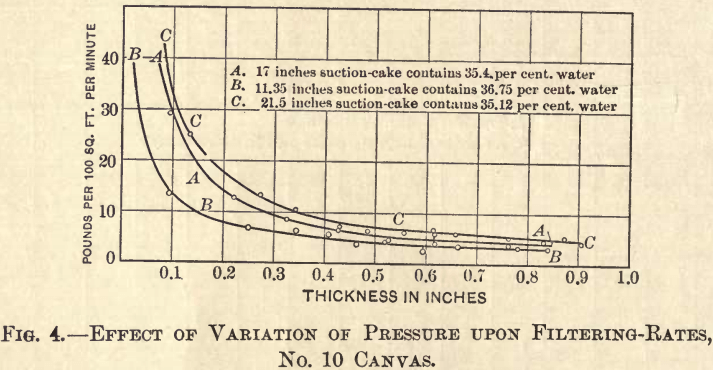
slime at Bodie, says: “ Filter-pressing was tried and abandoned, because an eighth of an inch of pure slime would make the cloths impervious, even under 120-lb. pressure; and even if the slime was mixed with fine sand, the filtering was so slow that the sand settled out in the chambers, with the same result.” The practical conclusion that may be drawn from a study of the effects of pressure in filtration is that, with material of a permeable nature such as a sandy slime, increased pressures over those obtainable by means of vacuum-pumps are advantageous, while with material in which only a moderate to a small amount of sand is present, and the permeability low, the use of higher pressures offers no advantages over those obtainable by vacuum-pumps. In the use of both the Moore and the Butters systems, experiments should be made with different intensities of vacuum, for it may be found that a vacuum lower than the maximum obtainable with the available apparatus will give a higher filtration-rate, and thus decrease the time for both building up and washing.
Fig. 5 gives the comparative filtering-rates of five slimes. The same test-filter, temperatures, and pressures were used in each case. No. 10 canvas was used on the filter. The slimes used were: a clay slime (a very plastic fire-clay) containing about 40 per cent, of sand which settled out in 1 min.; the average of the results on the type slime; a slime from a Virginia City tailings-pond; the type slime containing 37 per
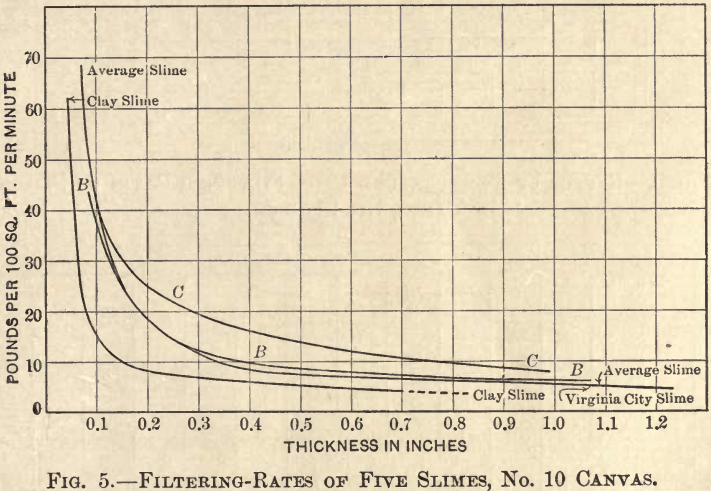
cent, of fine sand (determined on the basis of 1 min. settlement); the type slime with 52 per cent, of fine sand (determined on the basis of 1 min. settlement). The type slime on the basis of 1-min. settlement gave 6.5 per cent, of fine sand. B and C respectively represent the 37 and the 52 per cent, of fine-sand slimes.
The filtering-rate curves for the type slime and the Virginia City slime are coincident. The increase in the proportion of fine sand from 6.5 to 37 per cent, makes but very little difference in the filtration-rate. A further increase to 52 per cent, shows a marked increase in the filtering-rate (curve C). While the clay slime has a greater proportion of fine sand than either the type or B, the filtering-rate curve is much lower. The conclusions which may be drawn from these experiments are: slimes from similar ores subjected to the same metallurgical treatment give similar filtering-rate curves; a moderate variation in the proportion of fine sand gives filtering-rates differing
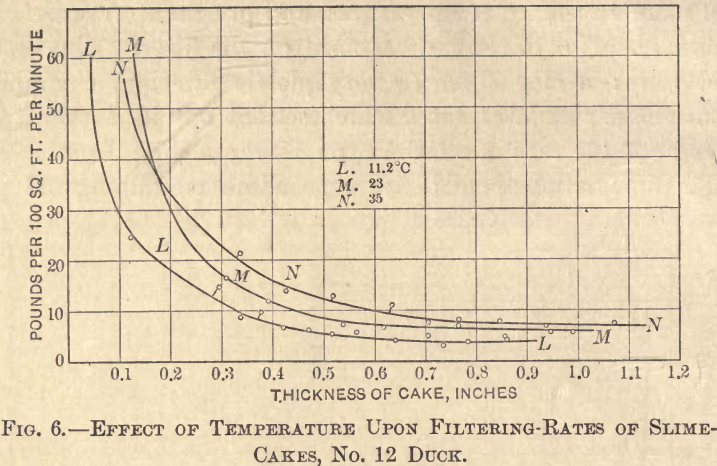

only to a small degree, while a considerable increase in the proportion of fine sand increases the filtering-rate; the proportion of colloidal matter, or, in this case, clay base, has a marked influence upon the filtering-rate; much more, relatively, than the effect of fine sands in increasing the filtering-rates. The amount of clay is the dominating factor in filtering-rates, and this fact is indicated by the curves approaching a common point as the thickness of the cake is increased.
Fig. 6 shows the effect of temperature upon the filtering-rate of the type slime. A No. 12 canvas was used on the filter for these experiments. For thin cakes the increase in filtering-rate is more marked than for the thicker cakes. The same tendency of the rate-curves to run together for the thicker cakes is to be noted.
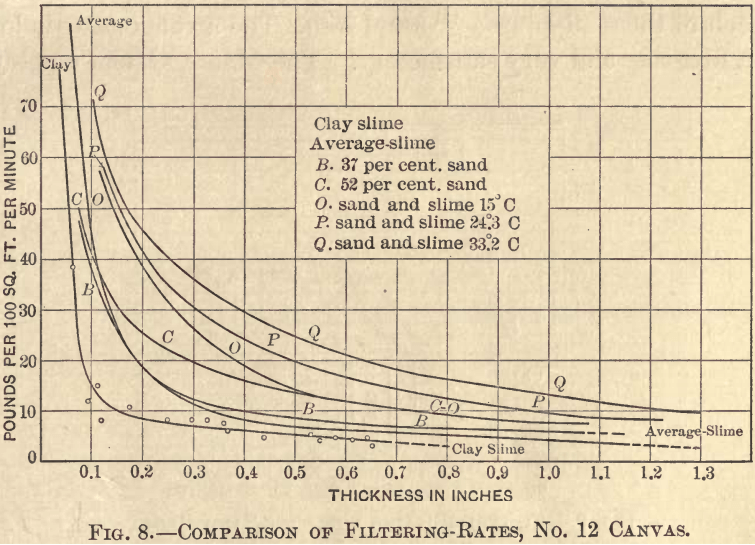
Fig. 7 shows the effect of temperature upon a slime containing 50 per cent, of fine sand and the type slime. The marked increase in filtering-rate, with moderately elevated temperatures, is so noticeable as to indicate a condition of considerable practical importance. By increasing the temperature of the pulp greater capacity could be readily obtained with a given unit. Fig. 8 compares the filtration-rates of the clay slime, the type slime, and the several sand-slime cakes. Fig. 9 compares the filtering-rates for fine-sand beds 3 in. thick under varying pressures.
Filtering Area
Most of the suction-filters employ No. 10 canvas duck for the filtering-surface. The Oliver filter makes use of a No. 12 and the Merrill filter-press of a No. 6 duck over a light twill. In the Butters and the Moore filters three methods of support are in common use. The original Butters unit consisted of canvas stitched at close intervals over a center sheet of cocoa matting, which gives a very porous gathering-space for the solutions and also sufficient support to the canvas. The objections to this construction are the cost, and the clogging of the matting. With the exception of the Goldfield Consolidated mill, all the mills in the Tonopah and Goldfield districts employ the “ slat method ” of support, which consists of sewing the canvas walls of the cell into narrow pockets from 1.5 to 2 in. wide, and into each of these slipping a grooved lath. The arrangement is low in first-cost and very satisfactory. The Moore system employs
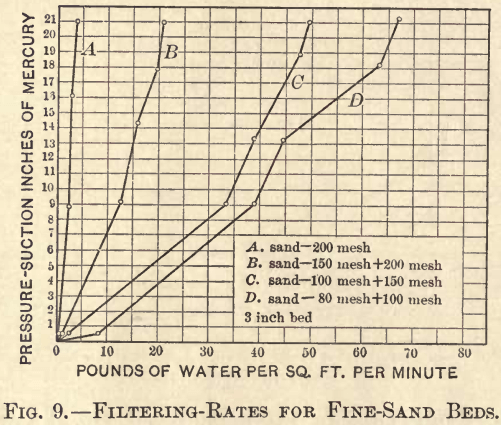
wooden strips slipped into narrow pockets in the canvas. The Moore system also makes use of wire netting between the canvas walls, the canvas being stitched at frequent intervals through the, netting. In the Oliver filter, wire netting over a grooved board and covered with 8-oz. burlap supports the canvas. The canvas is held against this base by wire wrapped around the canvas at 0.5-in. intervals. In both the Butters and the Moore filters wooden dividing-strips are used to space the filtering-surface into strips 1 ft. wide. Grooved iron plates are used in the filter-presses and in the Merrill press.
Durability and permeability are the necessary requirements of a filtering-cloth. Canvas duck, army weave, No. 10, answers both of these requirements for suction-filters. For pressure-filters this canvas is too light, and No. 6 gives sufficient durability without interfering with the filtration too much. On account of the wire wrapping, the Oliver filter can employ a lighter duck (No. 12). The relative permeability of different weights of canvas is a difficult matter to determine experimentally. It is a function of the weave of the cloth and the character of the supporting surface. In general, the lighter the weight of the duck the more permeable it is. Duck may be obtained in three weaves : army duck, in which the threads of warp and woof are twisted; double-fill, in which the warp thread is twisted and the woof threads are not twisted; single-fill, in which neither the warp nor the woof threads are twisted. Of
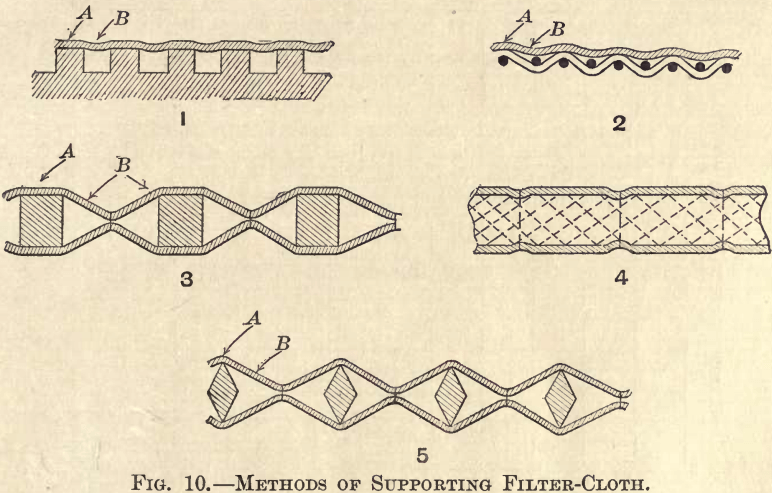
the three weaves the army duck is the least permeable, while the other two weaves are too open and porous to be of much use in slime-filtration.
Fig. 10 illustrates several methods of supporting the filtering- cloth. In method 1, the fibers of the cloth are distended and the cloth made more open at B, while at A the fibers are flattened and pressed against one another, with the result of reducing the permeability of the cloth over the ridges. The relative proportion of ridge to groove determines the decrease in permeability due to the support. No. 2 shows the wire netting support, and with this the rounded wires reduce the permeability to a less extent than the flat wooden ridges. In No. 3 the narrow wooden strips have less effect than the close ridges of No. 1, while between the strips the cloth is stretched and is more open. With No. 4 the permeability of the cloth is not generally effected, for the fibers may press into the soft cocoa matting. In No. 5 the diamond-shaped strips give the maximum proportion of distended canvas, and leave the fibers free from any flattening due to the pressure.
Fig. 11 shows the effect upon the filtering-rate of the type slime for three filters. Curve L is for No. 12 duck on a grooved wooden support similar to No. 1, Fig. 9; 41 per cent, of the cloth was supported and 59 per cent, unsupported. Curve S is for No. 12 duck supported on diamond-shaped
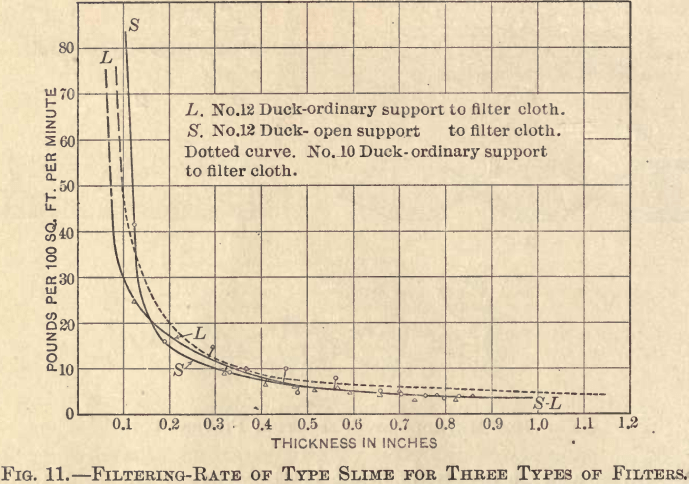
strips; 21 per cent, of the cloth was supported, 78 per cent, unsupported. The dotted curve is the average curve for the test-filter. A No. 10 duck was used and the same proportion of support given the cloth as for curve L. The heavier-weight duck on the grooved support gives a higher filtering-rate than the light weight on either the grooved or the more open support. The open support gives a higher filtering-rate for the thinner slime-cakes and lower rates for the thicker cakes. This anomalous result is explained by the fact that the more permeable the filter the more active becomes the filtering-surface for a given pressure and the more compactly the cake is built up. The general conclusion is that the permeability of the filter-cloth is a matter of moderate importance; of greater importance with the thin-cake suction-filters than with the thick-cake filters.
No experiments could be made on the comparative durability of filter-cloths. From data submitted in Table V. it appears that suction-filters, supported with cocoa matting, have the longest life. Close stitching is of importance both in maintaining an efficient filter and in prolonging the life of the filter-cloth. The first Moore filters were constructed with the canvas supported at 6-in. intervals, and these filters failed by tearing and weakening generally at the points of attachment. With stitching at 1-in. intervals the wear at the stitching-points is reduced very materially in the Butters filter. With the slat-filter narrow slats allow closer stitching, and this is the tendency in construction.
The grooved support results in practically a clear solution from the start of filtration whether a No. 10 or a No. 12 duck is used. The diamond-strip support and No. 12 canvas gave a turbid filtrate for the first minute of filtration.
The relation between numbered duck and ounce duck is as follows:

Slime Cakes
A slime-cake is built up of a succession of thin layers of slime. Slices taken from the surface, middle, and next the canvas showed varying percentages of water, and consequently a variation in density from the outer surface to the canvas. Fig. 12 represents graphically the results of sectioning different slime-cakes. B shows the proportion of sand, slime, and water for a cake made from the type slime. The cake was 0.81 in. thick, and the vacuum used 21 in. The outer 0.25 in. contained 41.4; the middle, 39.6; and the portion next the canvas, 33.8 per cent, of water. The respective specific gravities are 1.575, 1.605, and 1.715. The average water-content is 38.1 per cent., and the average specific gravity, 1.632. F and G are from two slime-cakes in which the respective proportions of sand were 37 and 52 per cent. The composition of sections of these cakes is given in Table I.
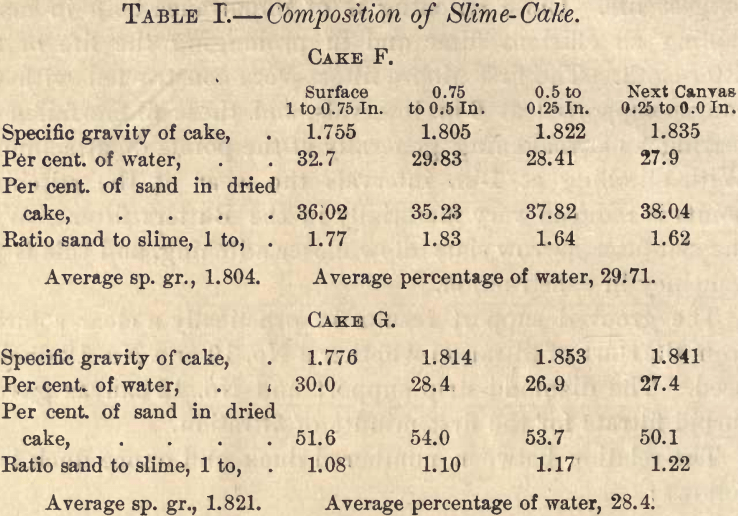
Comparing the results in Table I. with those given for the type slime, a variation in water-content of from 38.1 to 28.4 per cent., and in density of from 1.632 to 1.821, is shown for a variation in sand of from 6 to 52 per cent. The sand in these cakes was determined on the basis of 1-min. settlement. An increase in the proportion of fine sand decreases the interstitial space, but does not decrease the permeability, as the curves for filtering-rates show. For purposes of comparison the proportion of water absorbed by fine sands is shown in Fig. 12. Fine sands (quartz) between 80- and 100-mesh contain 26.4, and for sands passing a 200-mesh screen and from which all slime was elutriated, 28.1 per cent, of water. The volume relationship is also shown for both fine sands and slime in Fig. 12. The former shows 47.7 of water and 52.3 per cent, of solid; the latter, 60 of water and 40 of solid. These figures are of interest in that they show the comparatively large volume-proportion of water in the slime-cakes.
The comparative results between sand and slime show that the percentage of water is no indication of the permeability of a porous material.
In Fig. 12, H shows the results for the Virginia City slime; I, for the type slime built up under 21.7-in. vacuum (36.2 per cent, of moisture and 1.062 sp. gr.); J shows the same
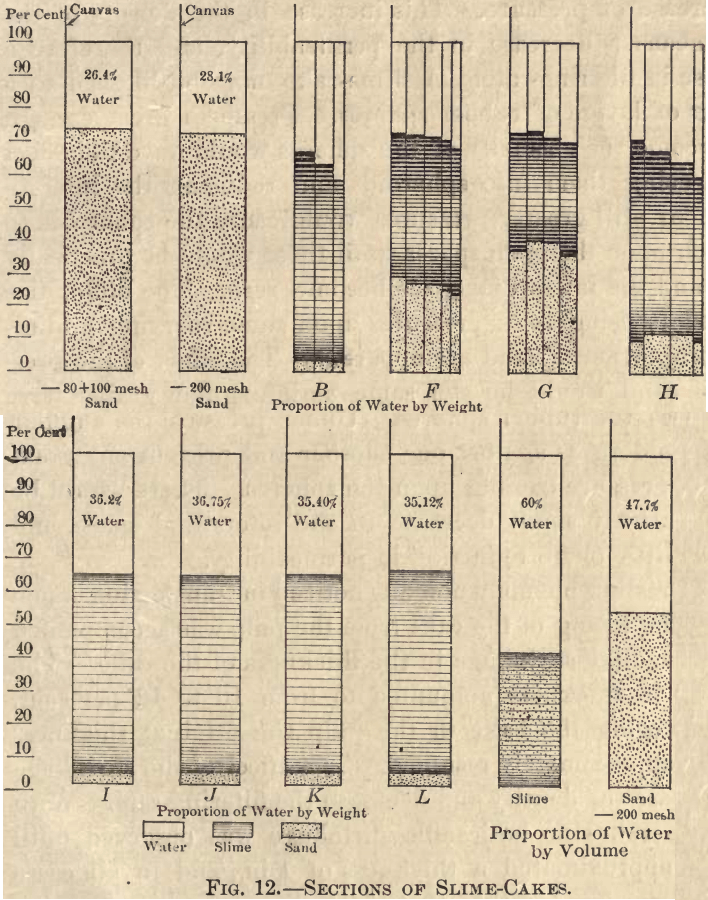
slime built up under 11.35-in. vacuum (36.75 per cent, of moisture and 1.65 sp. gr.); K shows the same slime built up under 17-in. vacuum (35.4 per cent, of moisture and 1.675 sp. gr.); L shows the same slime built up under 21.8-in. vacuum (35.12 per cent, of moisture and 1.683 sp. gr.).
The data of Fig. 12 serve also to show the effect of pressure upon the specific gravity of the slime-cake. To these may be added a slime-cake from the type slime which was built up on a slat-supported filter of No. 12 duck, giving with 21.5-in. vacuum a moisture-content of 33.6 per cent, and specific gravity of 1.71; and a cake built up under 30 lb. of air-pressure, giving 28.1 per cent, of moisture and 1.805 sp. gr. With the exception of K, there is an increase in the specific gravity with an increase of pressure. This increase in the density of the cake means a decrease in the permeability, and therefore a decrease in filtering-rate. A slime-cake may be likened to a number of layers of rubber spheres. Pressures great enough to overcome the elasticity of the spheres would have the effect of squeezing them into spheroids and reducing the interstitial space; still greater pressures would cause the spheroids to encroach upon the open spaces until these would be practically closed and the interstitial space become zero. The difficulties involved in using high pressures upon slime carrying a minimum proportion of sand are apparent. The effect of the presence of sand would be the same as if angular grains were mixed with the rubber spheres. Under pressure the angular grains would press against one another and prevent any great degree of pressure coming upon the spheres. There would be a comparatively small decrease in the interstitial space, and therefore little or no reduction in permeability.
An interesting phenomenon was noticed in transferring slime-cakes. The lifting of the cake from the pulp was accompanied by an immediate shrinkage in the thickness of the cake. The reduction in thickness amounted to from 10 to 12 per cent. On submerging the cake in the pulp the original thickness would be approximately resumed. The effect of the shrinkage is to increase the density and decrease the filtering-rate. With sand-slime cakes no noticeable shrinkage was observed until the cake approximated a thickness of 1 in., and in all cases this shrinkage was less than that of the-slime cake. During the building up of a slime-cake there is a progressive densification, somewhat slow and often irregular, which accounts for the erratic results obtained in some cases with the filtering-rate experiments.
The progressive densification of a slime-cake may be shown in another way. Subjecting a thick slime-calce to continued pressure when immersed in water, and determining the filtering-rate at several successive time-intervals, gives a slow drop in the filtering-rate.
Increase in temperature has a slight effect in increasing the density of the cake, but the experiments on this point were on the whole somewhat inconclusive.
The cracking of a slime-cake takes place under two conditions : when it is removed from the pulp and allowed to remain in the air under full pressure, and when removed from a pulp to water at a temperature 40° or 50° C. higher than the pulp. The latter condition is of little practical importance. The former is overcome by reducing the vacuum-pressure to just sufficient to hold the cake upon the cloth. Too long an exposure even at this pressure will cause a cake to crack. Under a vacuum-pressure of 21 in. a 1-in. cake will break down in from 2 to 10 min. Sand-slime cakes will stand a longer exposure than slime-cakes. The cause of cracking is lateral shrinkage, due to the displacement of the water by air and air-drying.
In building up cakes with vertically-suspended filtering-cells there is a tendency for the cake to build up thicker at the lower end. This is due to the increase of filtering-pressure due to increased hydrostatic head, and also to the thickening of the slime-pulp in the lower part of the filter-vat. Agitation will prevent, to a large extent, the building up of thick-ended cakes. Where the proportion of sand is large and the sand grains are coarse, agitation is quite necessary, but should not be too vigorous, as otherwise the building up of a cake would be seriously interfered with by erosion. With fine sands, finer than 200-mesh screen, if a pulp-density of 1.4 or more is maintained, little or no trouble is experienced by the sands settling out. Apparently the pulp, in the experiments, remained quite homogeneous for intervals of longer than one hour. With a greater proportion of water in the pulp moderate agitation is necessary in most cases.
Slime-cakes should be built up with vacuum-pressures as constant as possible, and should be kept completely submerged while the cake is forming. The temperature of the pulp and of the wash-water should be the same. Transfers from pulp to wash should be made as rapidly as possible and under reduced pressures. Filters in which the transfers are quickly made, and with the minimum of exposure of the cake to the air, are more efficient and maintain a higher filtering-rate than those in which long time-intervals are required for the necessary transfers.
Building up Slime Filter Cakes
Three direct factors control the rate of and the total time required for building up the cake: the thickness of the cake, the filtering-rate of the slime, and the proportion of water in the pulp. Indirectly, temperature, viscosity of the pulp, intensity of the vacuum used, depth of submersion of the cell, agitation, and the physical character of the slime, play a part in the building up of the cake. The effect of the indirect factors is summed up in the filtering-rate.
Practical experience has placed certain well-defined limits upon the thickness of the slime-cake. For example, the Ridgway filter utilizes a thickness of from 0.125 to 0.375 in.; the Oliver, from 0.25 to 0.5; the Butters and Moore, from 0.75 to 1.75; the Merrill, from 1.75 to 2; the Kelly, from 1 to 3, and the Burt revolving-filter, up to 6 in. With vertically-suspended filters the thick cakes tend to tear apart and drop during the transfers. The thickness of the cake also determines the time required for washing. Thick cakes require relatively a much longer time to wash than the thin, on account of the low filtering-rates, and the capacity of a filtering-unit may be very greatly cut down. With slime-cakes the lower limits mentioned above are used; with sand-slime cakes the upper limits may be used.
Other things being equal, the less solution that is required to be drawn through a filter in the building up of the cake the more quickly the cake will be secured, and consequently it is desirable to have the slime-pulp as low in content of water as possible. There is a practical limit to the thickening of the slime-pulp, and this is established by the settling-power of the pulp and the fluidity of the settled pulp. The settled pulp must be handled in pipes and with centrifugal pumps, and if it is too thick it becomes impossible to do this. A thick pulp is advantageous where much sand is to be held in suspension. In Nevada, with quartzose ores, pulp-ratios of from 3 of solution to 1 of slime down to 1.5 of solution to 1 of slime are in use. The average pulp in use is 2 of solution to 1 of slime.
Fig. 13 shows the relation between percentage of water and specific gravity of slime-pulp and cakes for a slime of specific gravity 2.62. Similar curves may be worked out for slimes of different specific gravity.
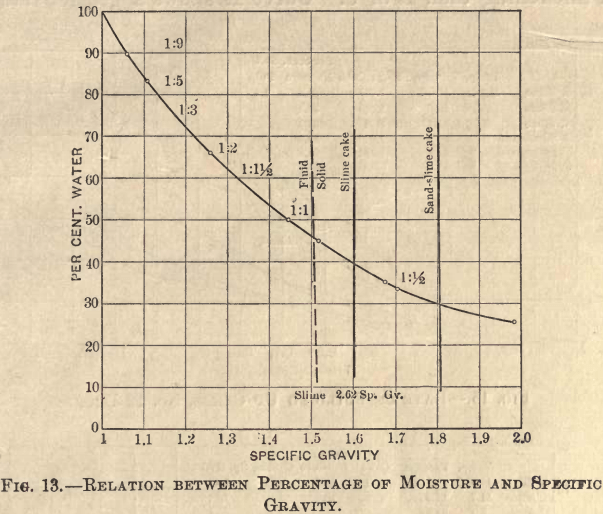
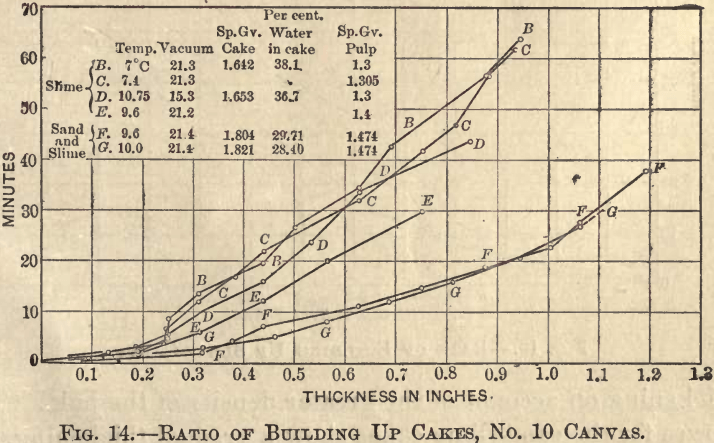
Fig. 14 shows the rate of building up slime-cakes on No. 10 canvas. Curves B, C, D, E are for the type slime ; curves F and G are for the type slime with mixtures of sand to the amount of 37 and 52 per cent., respectively. Curves B and C show a rapid consolidation of the cake at 0.25 in. thick, and then a gradual thickening. Curve D, built up at a lower pressure, shows a gradual thickening and a somewhat greater rate of thickening than B or C. Curve E shows a greater rate of
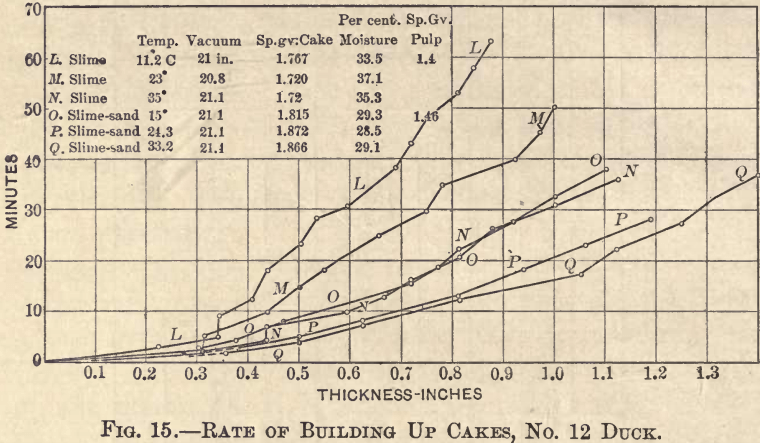
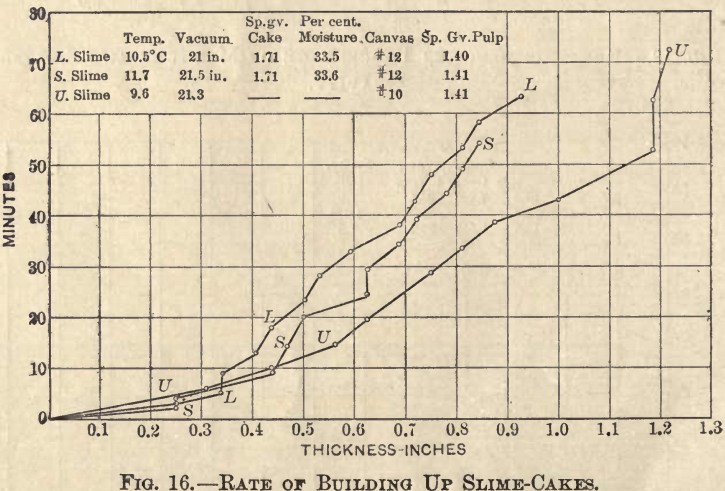
thickening on account of the greater density of the pulp. The curves for the sand-slime cakes show a gradual thickening.
Fig. 15 shows the rate of building up slime and sand-slime cakes on No. 12 duck under different temperature-conditions. Curves L, M, and N are for the type slime, and O, P, and Q for a sand-slime containing 52 per cent, of sand. All three slime-curves show greater irregularities than the sand-slime, and the sudden consolidation of the slime-cakes between 0.3 and 0.45 in. in thickness is characteristic. Increase of temperature increases the rate of building up to a marked extent.
The result of using a more permeable filter is illustrated by comparing Figs. 14 and 15. The significant curves are shown in Fig. 16. Curve L is the type slime built up on No. 12 duck supported on the grooved board; curve S is the type slime built up on No. 12 canvas and diamond-strip support. The more permeable filters show faster rates for the thin cakes and slower for the thick, than the less permeable filter with No. 10 duck. The diamond-strip-supported filter gives a faster rate than the grooved board.
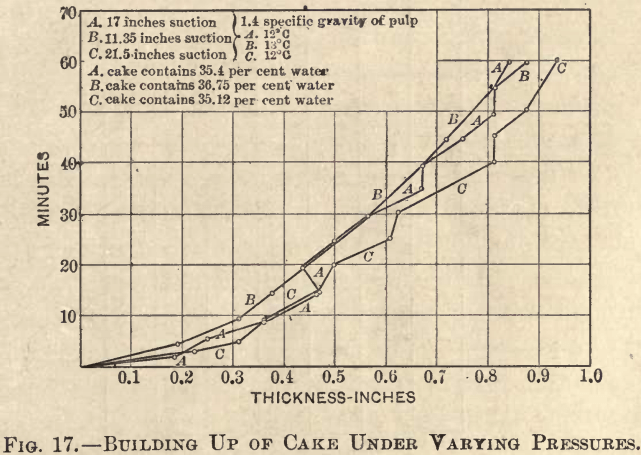
Fig. 17 shows the effect of pressure upon the rate of building up. The type slime and No. 10 duck were used in these experiments. Curve B, the rate-curve for the lowest pressure, is quite uniform; curve A is broken, and shows three consolidations ; curve C shows corresponding but not such prominent consolidations. The curves, on the whole, indicate that increased pressure, other things being equal, will increase the rate of building up.
Fig. 18 shows the rate of building up a slime-cake from a pulp made up from fire-clay. The very slow rate and the four pronounced consolidations extending over comparatively long time intervals are of interest.
The rate-curves indicate that as a slime-cake builds up a slow consolidation takes place, and superimposed upon this is an irregular and faster rate of consolidation. The irregular consolidation is characteristic of very slimy and clayey slimes, and becomes less so as the proportion of sand is increased. The sand diminishes the elastic nature of the slime-cake.
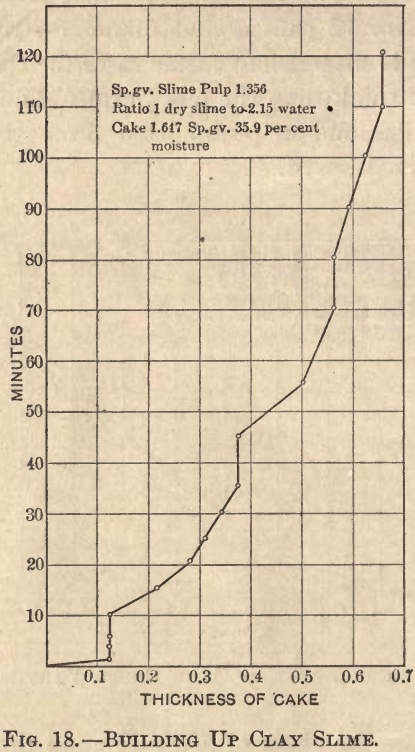
Filter Cake Washing
A slime-cake retains from 28 to 38 per cent, of solution; the former for sand-slime and the latter for slime-cakes. Were it not for osmosis, simple displacement with a volume of water equal to that retained by the cake would be sufficient to remove the dissolved salts of gold, silver, and cyanide. As it is, the soluble salts diffuse back into the wash-water, and in time this builds up in gold- and silver-values to such an extent that an appreciable loss results when, as in the Butters filter, the slime-cake is flushed out with the residual wash-water. By the use of two separate wash-solutions this difficulty can be more or less overcome; but it has the objection that an additional pumping of solution and exposure of the slime-cake to the air are necessitated. With the Moore, Oliver, and the pressure-filters generally, no great trouble is experienced from loss of values in the wash-solution, for in each case only that wash-water which is left in the cake after air-displacement takes place is discharged, and this amounts to from 20 to 30 per cent. In practice it is customary to use barren solution or wash-water in amount equal to from one to three times the amount of solution retained by the cake. With very low-grade solutions the former, and with high-grade solutions the latter, would be used. Twice the weight of the solution retained by the cake is usually sufficient to displace the values retained by the solution in the cake.
The thoroughness of washing is determined largely by the expense. When the value of the gold, silver, and cyanide recovered is less than the cost of recovery, washing stops.
It seems to me that with the thin-cake filtering-appliances a smaller proportion of wash-water would be required than for the thick-cake filters, for the reason that the rate of filtration is much higher with the former. Strength of solution, time, and temperature, are the controlling factors in osmosis; and of these, time is perhaps the most important; for the other two would be the same in either case. The shortness of the time required for washing and the relatively high filtering-rate in the case of the Oliver filter would give little opportunity for osmosis to interfere with the washing.
No washing-experiments were made with suction-filters. A few experiments were made with a pressure-filter in washing slime-cakes containing cyanide solutions. With pressures varying from 20 to 30 lb., and with a 0.2-per cent, cyanide solution, a 0.75-in. cake required from 1.3 to 1.4 times the contained water to reduce the cyanide-content to 0.02 per cent.
Complete Cycle of Filtration
Given the time for making all of the necessary transfers, the time for a complete cycle of operations may be approximated by using the filtering and building-up rate-curves. Two such examples have been worked out in Figs. 19 and 20. The former shows the time required for a complete cycle for the type slime, mixed with 50 per cent, of sand, both for single
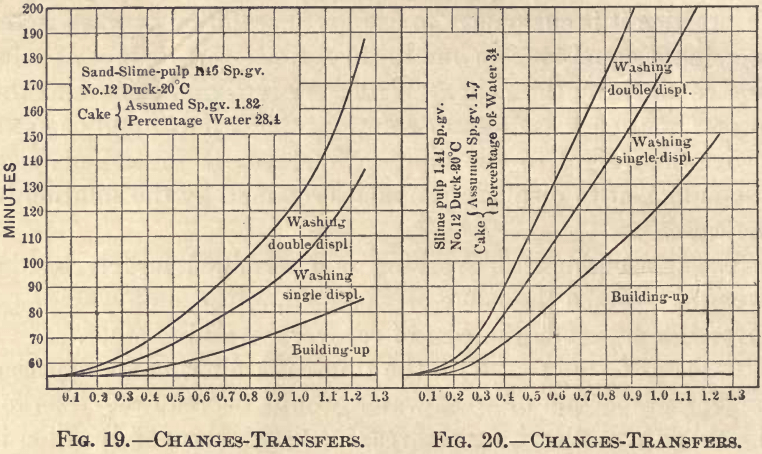
displacement and double displacement; while the latter shows the time required for the type slime. The 24-hr. capacity per 100 sq. ft. of filtering-surface may be calculated from the diagram, and the specific gravity of the cake and the percentage of moisture retained. Table II, shows the results of such calculations.
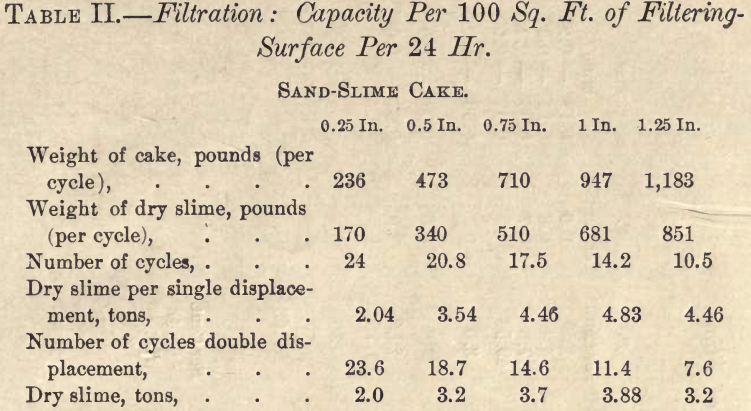
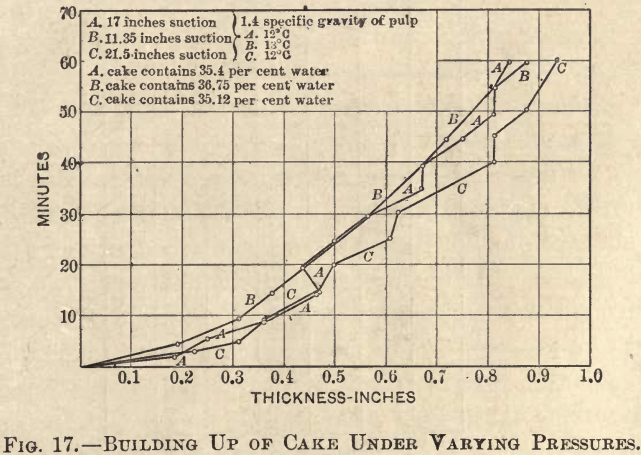
Table II. is constructed for a Butters filter, and the time for all the transfers is taken as 55 min. These data clearly show the impracticability of using thin cakes for filters of this type. Taking power-costs into account, it is advisable to have as few cycles as possible in filters of the Butters type, and this would be accomplished by building up thick cakes.
It should be noted that the capacities calculated are higher for the slime-cake than pertain in practice, for the reason that a thicker slime-pulp than is ordinarily the custom was used and consequently the time for building up was less.
By using a different horizontal axis in Figs. 19 and 20, the time required for a complete cycle for other suction-filters may be read off and calculations made for capacity.
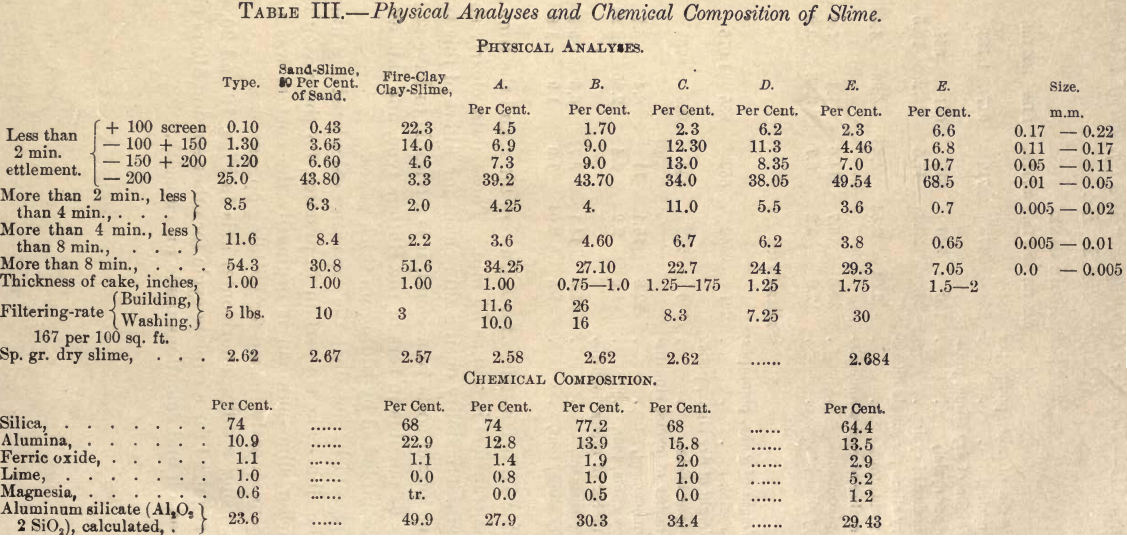
Data from Slime Filtration Plants
Data were secured from a number of slime-plants in Nevada through the courtesy of the different managers. Table III. shows the results of a number of physical analyses of slimes obtained from these plants. For purposes of comparison the type slime, the sand-slime mixture, the clay slime, and the filtering-rates are included in the table. The screen-analysis was conducted as follows: A 50-g. sample was taken and mixed thoroughly in a mortar to a thin pulp and then poured into an 800-cc. beaker and sufficient water added to make a volume of 600 cc., or approximately a ratio of 1 of slime to 12 of water. After stirring, beaker No. 1 was allowed to stand 2 min. and the contents poured into a beaker of the same size. The sand left in the bottom was mixed with 600 cc. of water; allowed to settle 2 min.; contents of beaker No. 2 were then poured into beaker No. 3 and of No. 1 into beaker No. 2; after standing 2 min. contents of No. 3 were poured into No. 4, of No. 2 into No. 3, and of No. 1 into No. 2. No. 1 was filled again and all beakers allowed to stand 2 min. Contents of No. 4 were poured into a 1.5-1. beaker, of No. 3 into No. 4, of No. 2 into No. 3, and of No. 1 into No. 2. No. 1 was left and the steps repeated until all four beakers were empty but for the sands and the reject in two 1.5-1. beakers. The sands were washed into pans and dried and then screen-analyzed through 100-, 150- and 200-mesh screens. The portion of the pulp in the large beakers was stirred and allowed to settle 4 min. and poured off; the sands constituted the 4-min. portion. Stirring and standing 8 min. gave the next to the last portion, and the last portion constituted the remainder. The sands obtained by this method were clean and free from adhering grains and were almost all silica. The size of the grains in the various portions was approximated by measurement with a microscope.
The type and the clay slimes stand out conspicuously. The type slime mixed with 50 per cent, of sand and the mill-slimes compare quite closely. Pulp F is a concentrate treated by agitation and pressure-filtration in a Kelley filter. Practically all of the mill-pulp considered as slime passes a 100-mesh screen; 88 per cent, is finer than a No. 150 screen and 79 per cent, finer than a No. 200 screen. The fine portion which takes more than 8 min. to settle gives an average of 27.5 per cent, for the mill-pulps. The chemical investigation was not completed, but the results of partial analyses are sufficiently interesting to include. With two exceptions, the type slime and mill-slime C, the calculated percentage of aluminum silicate corresponds approximately with the portion of the pulp taking longer than 8 min. to settle. Microscopical examination of the coarser portions show them to consist almost entirely of silica. The results on the type slime indicate that considerable silica remains with the last portion of the slime. Slime C is from the Goldfield Consolidated mill; as is well known, part of the alumina is present as alunite, and consequently the calculation of all of the alumina to aluminium silicate gives a result too high. The results of the chemical analyses indicate that by combining physical and chemical methods an approximate separation and quantitative determination of crystalline and colloidal material may be effected.
Table IV. gives the data of the slime-plants from which the mill-slimes in Table III. were taken.
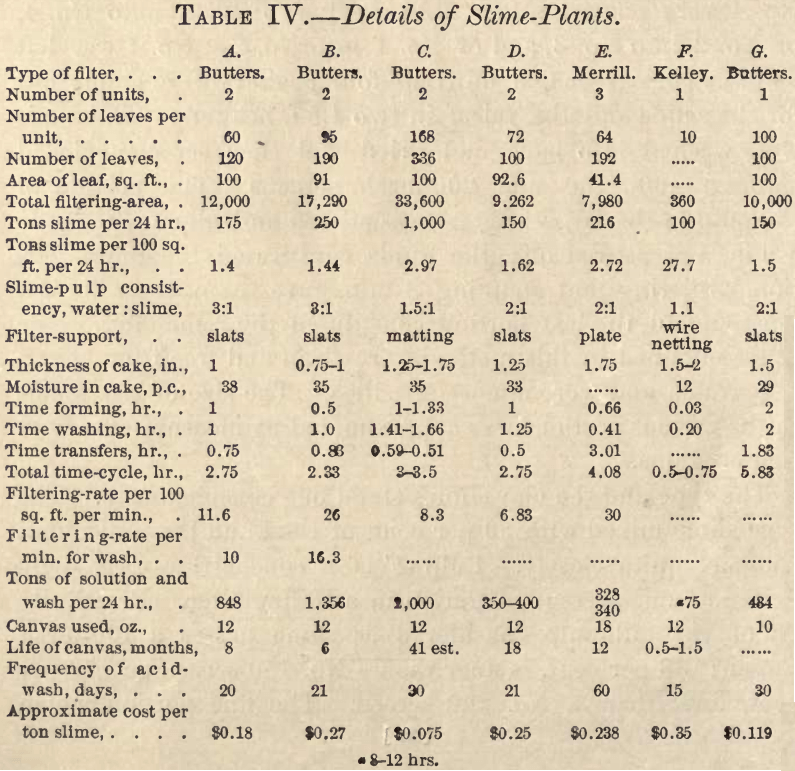
Conclusions
Certain practical conclusions may be drawn from the experimental work. These have been in part stated, but may not be out of place here, together with certain general conclusions which are not so directly shown by the experimental work. They are:
- The proportion of clayey material in ores which are to be subjected to “ all-sliming” and filtration should be maintained at a minimum.
- The slime-pulp should be as free as possible from sands coarser than a No. 150 screen, and as large a proportion of the pulp as possible should consist of material passing a No. 200 screen.
- The slime-pulp before filtration should be settled to as thick a consistency as possible consistent with ready handling by pumps and in pipes.
- The temperature of the slime-pulp should be maintained between 20° and 30° C. or higher.
- The temperature of the wash-water and the pulp should be the same.
- Vacuum-pressures should be varied until the proper intensity for the given slime is obtained.
- Where very clayey slime is to be filtered, as much fine sand (limited as stated above) should be crowded into the pulp as it will carry without undue settling and clogging.
- No. 10 canvas supported by slats gives the best all-round service for the thick cake, and No. 12 canvas on wire netting answers the requirements for the thin-cake filtering-machines.
- With slimes containing a large proportion of colloid or clayey material pressures greater than those obtainable with vacuum apparatus are of questionable advantage.
- With slimes containing a large proportion of clayey material the vacuum-filters should be used.
- With slimes containing a small proportion of clayey material and much fine sand both vacuum-filters and pressure-filters could be used with perhaps equally good results.
- With slimes containing much coarse and fine sand the chamber-filters with air-agitation and high pressures would perhaps give the best results.
- Of the vacuum-filters, the thin-cake continuous filters are a decided improvement over the thick-cake filters.
